DENTAL SLEEP MEDICINE
Snoring vs. Obstructive Sleep Apnea (OSA)
Many patients who snore often seek treatment to alleviate the social embarrassment. Snoring occurs when the tongue partially blocks a patient's airway. This disruption to sleep can contribute to fatigue and leave the sufferer feeling tired, drowsy, and sleepy. The prolonged effects of these problems can lead to slowed responses, memory problems, and difficulty in concentrating. These patients are not aware that their snoring is possibly only a symptom of a very serious and sometimes life threatening condition called Obstructive Sleep Apnea (OSA). OSA occurs when the tongue completely blocks the airway. Both of these scenarios cause a deprivation of oxygen that not only fragments sleep, but also contributes to a higher incidence of fatal diseases such as high blood pressure, stroke and heart attacks.
NORMAL
During normal sleep, the muscles that control the tongue and soft palate hold the airway open.
SNORING
When these muscles relax, the airway narrows. This can lead to snoring and breathing difficulties.
OBSTRUCTIVE SLEEP APNEA (OSA)
If the muscles relax too much, the airway can collapse and become blocked, causing an obstruction.
| Type of OSA | Number of Occurrences per Hour |
|---|---|
| Mild OSA | 5 to 15 |
| Moderate OSA | 15 to 30 |
| Severe OSA | 30 plus |
Adults are not the only people who experience obstructive sleep disturbances; children are also sometimes affected, especially when they have enlarged tonsils. There is also recent evidence that ADD and ADHD can sometimes be caused by obstructive sleep apnea or sleep disturbances. Any patient who has symptoms that may indicate OSA should promptly be evaluated.
SYMPTOMS
There are many symptoms that possibly indicate obstructive sleep apnea. Some of, but not all of these symptoms are:
- Gasping for breath while trying to sleep
- Frequent waking while sleeping
- Grinding of teeth
- Loss of memory
- Difficulty concentrating
- Fatigue
Our dentists, who have been specially trained in dental sleep medicine can work with your physician as part of your medical team to obtain a diagnosis and determine the best course of treatment. A couple of tests that our office offers that can help diagnose obstructions in the airway are rhinometry and pharyngometry. These tests evaluate the nasal and oral airway passages. Our office also offers an overnight sleep study that allows patients to complete the study in the comfort of their own home. This test can be used to evaluate the effectiveness of treatment.
DIAGNOSTIC EQUIPMENT
The Eccovision is a self-contained processor that emits soundwaves through two implements: the pharyngometer and rhinometer. The soundwaves travel through the rhinometer into the nasal passages and into the oral airway through the pharyngometer.
The soundwaves sent into the nasal passages and the oral airway map the anatomy of the airway, graphing a real-time picture of the airway that includes locations of narrowing and possible obstruction as well as its widest points. This is called Acoustic Reflection. It has a standard deviation of accuracy of .07%.
The procedure is completely painless and non-invasive and is performed chairside. It is not necessary for the patient to lie down. The airway scan can be immediately printed out and discussed with the patient or inserted into records for further reference.
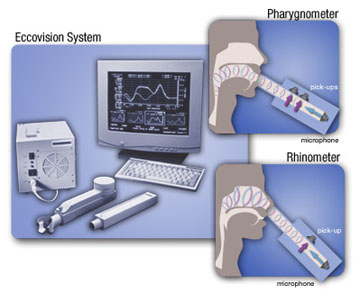
PULSE OXIMETERS
A pulse oximeter is a medical device that indirectly measures the oxygen saturation of a patient's blood (as opposed to measuring oxygen saturation directly through a blood sample) and changes in blood volume in the skin, producing a photoplethysmograph. It is often attached to a medical monitor so staff can see a patient's oxygenation at all times.
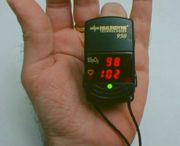
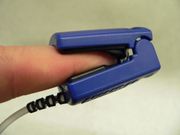
Watch-Pat 100
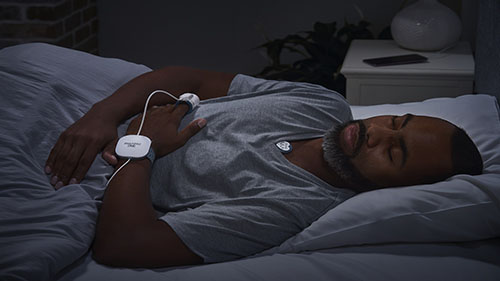
The WatchPAT® ONE consists of a fingertip probe and wearable wrist unit. Both devices are placed on the wrist and finger just before going to bed. During sleep, the system measures blood oxygen saturation levels, changes in blood flow and pulse rate. The signals are recorded onto a memory card. The memory card can be removed by the doctor and downloaded into a computer for analysis.
TREATMENT OPTIONS
Many patients who are prescribed a CPAP machine find that they are not able to tolerate it. Recent studies indicate that approximately 80% of CPAP users are non-compliant after just one year of use. Dental sleep medicine now offers alternatives for patients who cannot use CPAP. One of the alternatives that our office offers is The SomnoMed MAS, a mandibular advancement splint. The splint treats snoring and mild to moderate OSA by moving the jaw forward slightly. This forward movement tightens the soft tissues and muscles of the upper airway, which prevents the tissues of the upper airway from vibrating as air passes over them-the most common cause of loud snoring. The SomnoMed MAS is a highly effective solution for the majority of patients, to the problem of loud snoring and mild to moderate OSA. To learn more about this device, please visit www.somnomed.com.
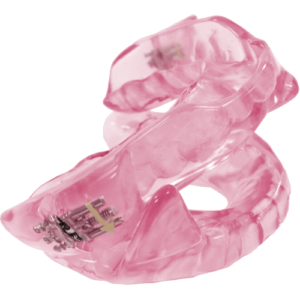
FINANCIAL POLICY
Payment for all sleep and TMD treatment is due at the time of service. For your convenience, we accept cash, check, and all major credit cards. Sleep and TMD treatment may be submitted to your medical insurance. Our office will supply you with a superbill that can be sent to your insurance company for reimbursement.
